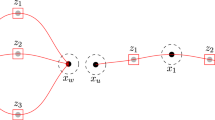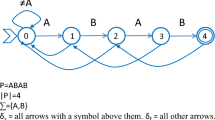Abstract
The computational complexity of internal diffusion-limited aggregation (DLA) is examined from both a theoretical and a practical point of view. We show that for two or more dimensions, the problem of predicting the cluster from a given set of paths is complete for the complexity class CC, the subset of P characterized by circuits composed of comparator gates. CC-completeness is believed to imply that, in the worst case, growing a cluster of size n requires polynomial time in n even on a parallel computer. A parallel relaxation algorithm is presented that uses the fact that clusters are nearly spherical to guess the cluster from a given set of paths, and then corrects defects in the guessed cluster through a nonlocal annihilation process. The parallel running time of the relaxation algorithm for two-dimensional internal DLA is studied by simulating it on a serial computer. The numerical results are compatible with a running time that is either polylogarithmic in n or a small power of n. Thus the computational resources needed to grow large clusters are significantly less on average than the worst-case analysis would suggest. For a parallel machine with k processors, we show that random clusters in d dimensions can be generated in \(\mathcal{O}\)((n/k+logk)n 2/d) steps. This is a significant speedup over explicit sequential simulation, which takes \(\mathcal{O}\)(n 1+2/d) time on average. Finally, we show that in one dimension internal DLA can be predicted in \(\mathcal{O}\)(logn) parallel time, and so is in the complexity class NC.
Similar content being viewed by others
REFERENCES
F. Barahona, On the computational complexity of Ising spin glass models, J. Phys. A 15:3241–3253 (1982).
R. M. Brady and R. C. Ball, Fractal growth of copper electrodeposits, Nature 309:225–229 (1984).
M. Bramson and J. L. Lebowitz, Asymptotic behavior of densities for two-particle annihilating random walks, J. Stat. Phys. 62:297–372 (1991).
A. Condon, A theory of strict P-completeness, STACS 1992, in Lecture Notes in Computer Science 577:33–44 (1992).
D. Dhar, The Abelian sandpile and related models, Physica A 263:4–25 (1999).
P. Diaconis and W. Fulton, A growth model, a game, an algebra, Lagrange inversion, and characteristic classes, Rend. Sem. Mat. Univ. Pol. Torino 49:95–119 (1991).
R. M. D'souza and N. H. Margolus, A thermodynamically reversible generalization of diffusion-limited aggregation, Phys. Rev. E. 60:264–274 (1999).
F. Family, B. R. Masters, and D. E. Platt, Fractal pattern formation in human retinal vessels, Physica D 38:98–103 (1989).
J. Gravner and J. Quastel, Internal DLA and the Stefan problem, Ann. Prob., to appear.
R. Greenlaw, H. J. Hoover, and W. L. Ruzzo, Limits to Parallel Computation: P-Com-pleteness Theory (Oxford University Press, 1995).
D. Griffeath and C. Moore, Life without death is P-complete, Complex Systems 10: 437–447 (1996).
H. G. E. Hentschel and A. Fine, Diffusion-regulated control of cellular dendritic morphogenesis, Proc. R. Soc. Lond. B 263:1–8 (1996).
D. E. Knuth, Seminumerical Algorithms (Addison-Wesley, 1981).
J. Krug and P. Meakin, Kinetic roughening of Laplacian fronts, Phys. Rev. Lett. 66:703 (1991).
H. Larralde, P. Trunfio, S. Havlin, H. E. Stanley, and G. H. Weiss, Territory covered by N diffusing particles, Nature 355:423–426 (1992).
G. Lawler, M. Bramson, and D. Griffeath, Internal diffusion limited aggregation, Ann. Prob. 20:2117-2140 (1992).
G. Lawler, Subdiffusive fluctuations for internal diffusion limited aggregation, Ann. Prob. 23:71–86 (1995).
K. Lindgren and M. G. Nordahl, Universal computation in simple one-dimensional cellular automata, Complex Systems 4:299–318 (1990).
J. Machta, The computational complexity of pattern formation, J. Stat. Phys. 70:949 (1993).
J. Machta and R. Greenlaw, The parallel complexity of growth models, J. Stat. Phys. 77:755 (1994).
J. Machta and R. Greenlaw, The computational complexity of generating random fractals, J. Stat. Phys. 82:1299 (1996).
J. G. Masek and D. L. Turcotte, A diffusion-limited aggregation model for the evolution of drainage networks, Earth and Planetary Science Letters 119:379–386 (1993).
E. W. Mayr and A. Subramanian, The complexity of circuit value and network stability, J. Comput. System Sci. 44:302–323 (1992).
P. Meakin and J. M. Deutch, The formation of surfaces by diffusion-limited annihilation, J. Chem. Phys. 85:2320 (1986).
A. M. Meirmanov, The Stefan Problem (Walter de Gruyter, Berlin, 1992).
C. Moore and M. Nilsson, The computational complexity of sandpiles, J. Stat. Phys. 96:205–224 (1999).
C. Moore, Majority-Vote cellular automata, Ising dynamics, and P-completeness, J. Stat. Phys. 88:795–805 (1997).
C. Moore and M. Nordahl, Predicting lattice gases is P-complete (Santa Fe Institute Working Paper 97-04-034).
C. Moore, Quasi-linear cellular automata, Physica D 103:100–132 (1997); Proceedings of the International Workshop on Lattice Dynamics.
C. Moore, Predicting non-linear cellular automata quickly by decomposing them into linear ones, Physica D 111:27–41 (1998).
K. Moriarty and J. Machta, The computational complexity of the Lorentz lattice gas, J. Stat. Phys. 87:1245 (1997).
K. Moriarty, J. Machta, and R. Greenlaw, Optimized parallel algorithm and dynamic exponent for diffusion-limited aggregation, Phys. Rev. E 55:6211 (1997).
L. Niemeyer, L. Pietronero, and H. J. Wiesmann, Fractal dimension of dielectric breakdown, Phys. Rev. Lett 52:1033–1036 (1984).
J. Nittmann and H. E. Stanley, Tip splitting without interfacial tension and dendritic growth patterns arising from molecular anisotropy, Nature 321:663 (1986).
J. Nittmann and H. E. Stanley, Non-deterministic approach to anisotropic growth pat-terns with continuously tunable morphology: the fractal properties of some real snow-flakes, J. Phys. A 20: L1185 (1987).
C. H. Papadimitriou, Computational Complexity (Addison-Wesley, 1994).
L. Paterson, Diffusion-limited aggregation and two-fluid displacement in porous media, Phys. Rev. Lett. 52:1621 (1984).
C. Tang, Diffusion-limited aggregation and the Saffman-Taylor problem, Phys. Rev. A 31: 1977 (1985).
D. Toussaint and F. Wilczek, Particle-antiparticle annihilation in diffusive motion, J. Chem. Phys. 78:2642–2647 (1983).
T. Witten and L. Sander, Diffusion-limited aggregation: a kinetic critical phenomenon, Phys. Rev. Lett. 47:1400-1403 (1981).
Author information
Authors and Affiliations
Rights and permissions
About this article
Cite this article
Moore, C., Machta, J. Internal Diffusion-Limited Aggregation: Parallel Algorithms and Complexity. Journal of Statistical Physics 99, 661–690 (2000). https://doi.org/10.1023/A:1018627008925
Issue Date:
DOI: https://doi.org/10.1023/A:1018627008925




